CA3417 Management for Construction: Organizational Structures Report
VerifiedAdded on 2022/12/26
|5
|1667
|1
Report
AI Summary
This report examines organizational structures within the context of construction management, focusing on functional, product, and matrix structures, comparing and contrasting their characteristics. It explores how these structures impact project timelines, budget, and quality. The report also investigates factors that attract and retain employees in design and construction firms, emphasizing employee remuneration, training and development, and working environment. The analysis highlights the importance of fair compensation, continuous learning opportunities, and a supportive work environment for maintaining a skilled workforce. The conclusion underscores the need for organizations to select structures that align with their objectives, promote effective information flow, and empower employees to contribute to the success of construction projects. This report is a comprehensive analysis of organizational structures and workforce strategies in construction management.
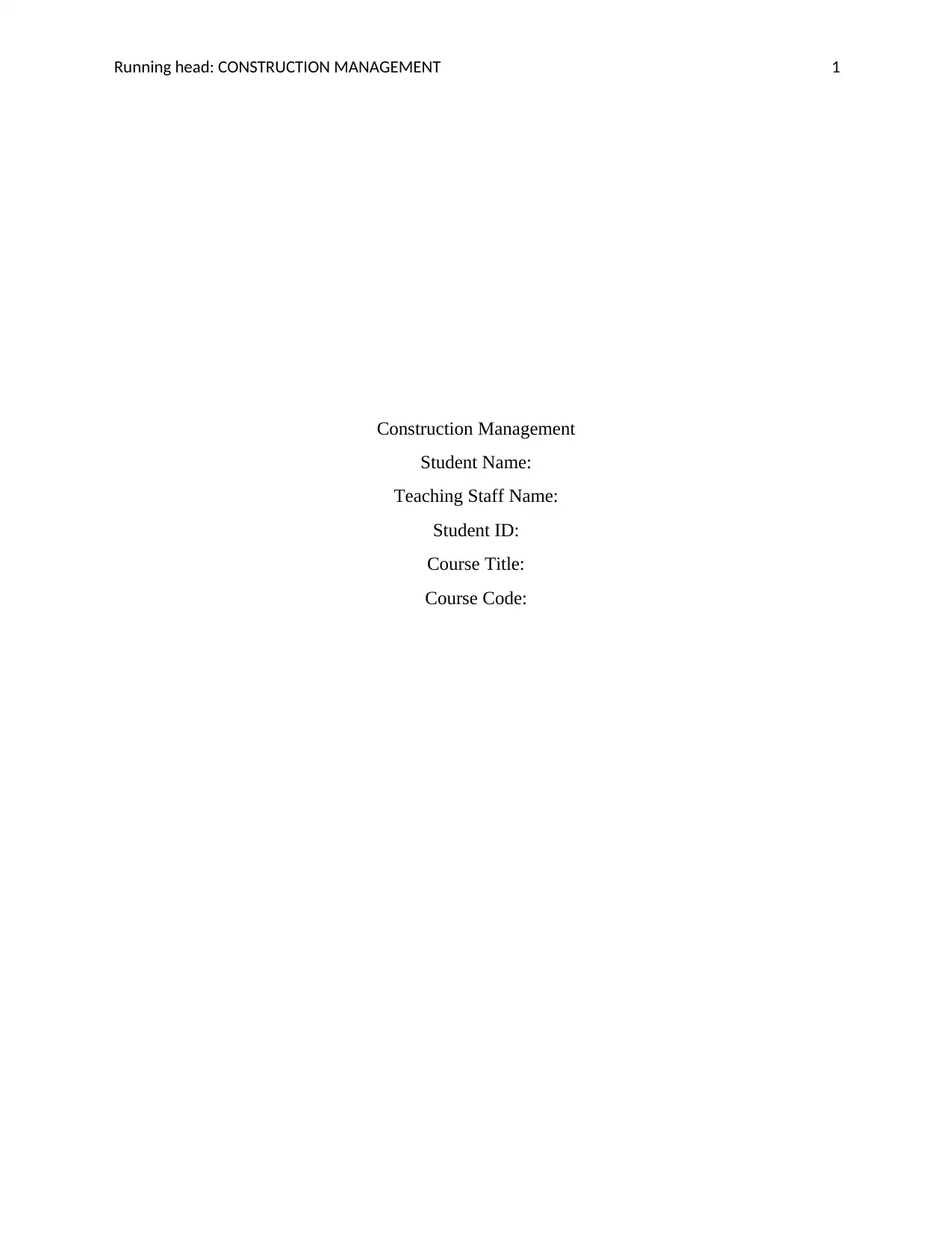
Running head: CONSTRUCTION MANAGEMENT 1
Construction Management
Student Name:
Teaching Staff Name:
Student ID:
Course Title:
Course Code:
Construction Management
Student Name:
Teaching Staff Name:
Student ID:
Course Title:
Course Code:
Paraphrase This Document
Need a fresh take? Get an instant paraphrase of this document with our AI Paraphraser
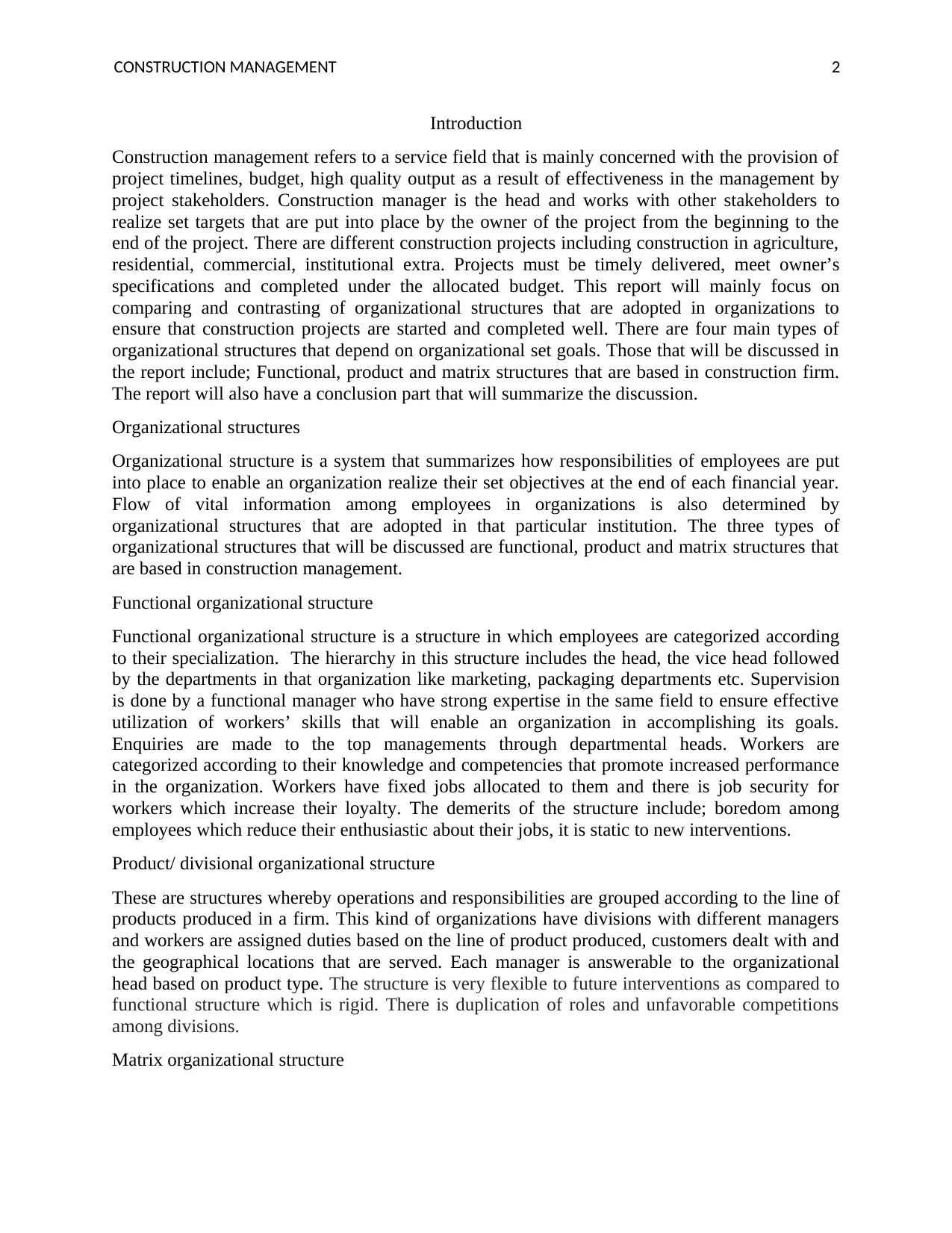
CONSTRUCTION MANAGEMENT 2
Introduction
Construction management refers to a service field that is mainly concerned with the provision of
project timelines, budget, high quality output as a result of effectiveness in the management by
project stakeholders. Construction manager is the head and works with other stakeholders to
realize set targets that are put into place by the owner of the project from the beginning to the
end of the project. There are different construction projects including construction in agriculture,
residential, commercial, institutional extra. Projects must be timely delivered, meet owner’s
specifications and completed under the allocated budget. This report will mainly focus on
comparing and contrasting of organizational structures that are adopted in organizations to
ensure that construction projects are started and completed well. There are four main types of
organizational structures that depend on organizational set goals. Those that will be discussed in
the report include; Functional, product and matrix structures that are based in construction firm.
The report will also have a conclusion part that will summarize the discussion.
Organizational structures
Organizational structure is a system that summarizes how responsibilities of employees are put
into place to enable an organization realize their set objectives at the end of each financial year.
Flow of vital information among employees in organizations is also determined by
organizational structures that are adopted in that particular institution. The three types of
organizational structures that will be discussed are functional, product and matrix structures that
are based in construction management.
Functional organizational structure
Functional organizational structure is a structure in which employees are categorized according
to their specialization. The hierarchy in this structure includes the head, the vice head followed
by the departments in that organization like marketing, packaging departments etc. Supervision
is done by a functional manager who have strong expertise in the same field to ensure effective
utilization of workers’ skills that will enable an organization in accomplishing its goals.
Enquiries are made to the top managements through departmental heads. Workers are
categorized according to their knowledge and competencies that promote increased performance
in the organization. Workers have fixed jobs allocated to them and there is job security for
workers which increase their loyalty. The demerits of the structure include; boredom among
employees which reduce their enthusiastic about their jobs, it is static to new interventions.
Product/ divisional organizational structure
These are structures whereby operations and responsibilities are grouped according to the line of
products produced in a firm. This kind of organizations have divisions with different managers
and workers are assigned duties based on the line of product produced, customers dealt with and
the geographical locations that are served. Each manager is answerable to the organizational
head based on product type. The structure is very flexible to future interventions as compared to
functional structure which is rigid. There is duplication of roles and unfavorable competitions
among divisions.
Matrix organizational structure
Introduction
Construction management refers to a service field that is mainly concerned with the provision of
project timelines, budget, high quality output as a result of effectiveness in the management by
project stakeholders. Construction manager is the head and works with other stakeholders to
realize set targets that are put into place by the owner of the project from the beginning to the
end of the project. There are different construction projects including construction in agriculture,
residential, commercial, institutional extra. Projects must be timely delivered, meet owner’s
specifications and completed under the allocated budget. This report will mainly focus on
comparing and contrasting of organizational structures that are adopted in organizations to
ensure that construction projects are started and completed well. There are four main types of
organizational structures that depend on organizational set goals. Those that will be discussed in
the report include; Functional, product and matrix structures that are based in construction firm.
The report will also have a conclusion part that will summarize the discussion.
Organizational structures
Organizational structure is a system that summarizes how responsibilities of employees are put
into place to enable an organization realize their set objectives at the end of each financial year.
Flow of vital information among employees in organizations is also determined by
organizational structures that are adopted in that particular institution. The three types of
organizational structures that will be discussed are functional, product and matrix structures that
are based in construction management.
Functional organizational structure
Functional organizational structure is a structure in which employees are categorized according
to their specialization. The hierarchy in this structure includes the head, the vice head followed
by the departments in that organization like marketing, packaging departments etc. Supervision
is done by a functional manager who have strong expertise in the same field to ensure effective
utilization of workers’ skills that will enable an organization in accomplishing its goals.
Enquiries are made to the top managements through departmental heads. Workers are
categorized according to their knowledge and competencies that promote increased performance
in the organization. Workers have fixed jobs allocated to them and there is job security for
workers which increase their loyalty. The demerits of the structure include; boredom among
employees which reduce their enthusiastic about their jobs, it is static to new interventions.
Product/ divisional organizational structure
These are structures whereby operations and responsibilities are grouped according to the line of
products produced in a firm. This kind of organizations have divisions with different managers
and workers are assigned duties based on the line of product produced, customers dealt with and
the geographical locations that are served. Each manager is answerable to the organizational
head based on product type. The structure is very flexible to future interventions as compared to
functional structure which is rigid. There is duplication of roles and unfavorable competitions
among divisions.
Matrix organizational structure
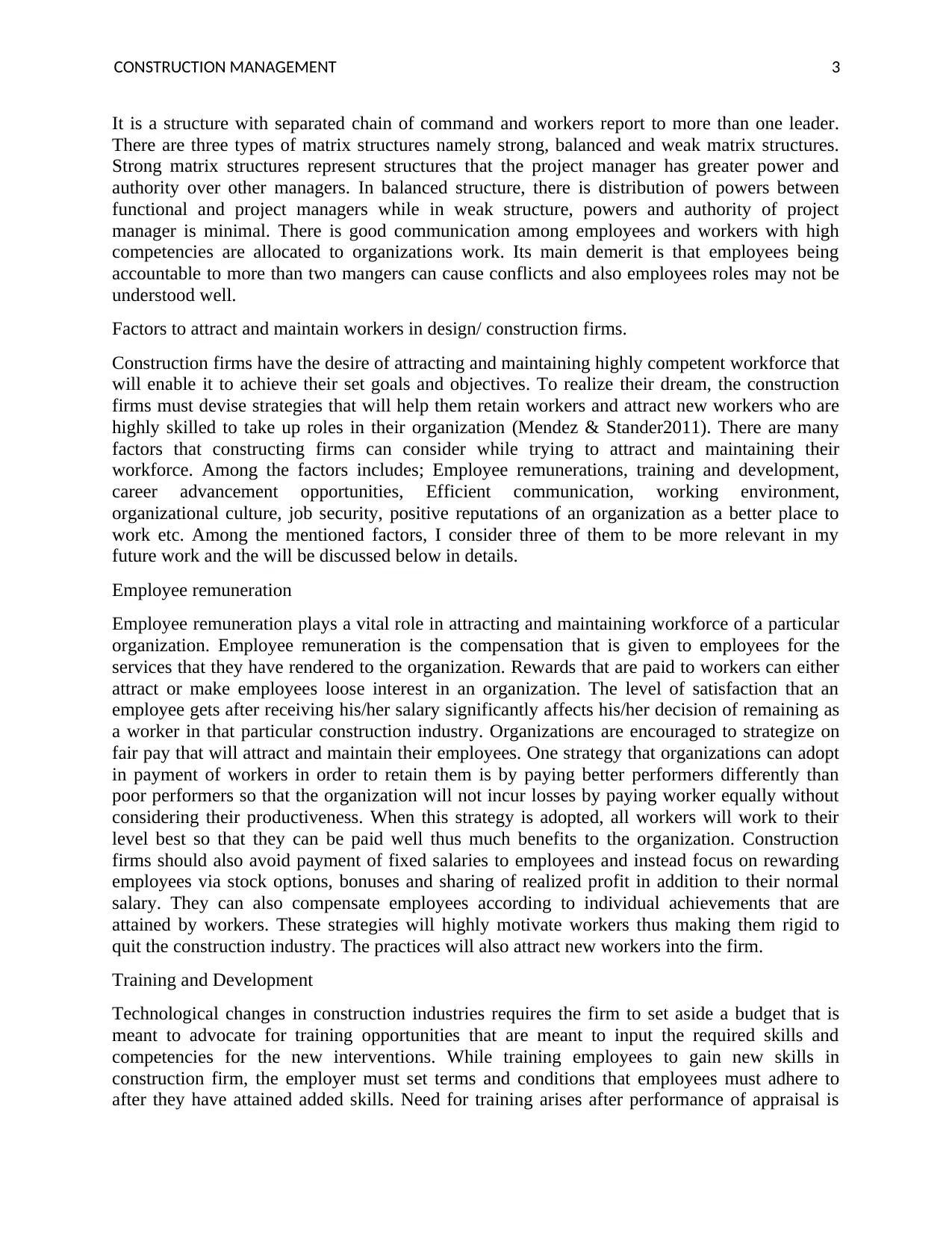
CONSTRUCTION MANAGEMENT 3
It is a structure with separated chain of command and workers report to more than one leader.
There are three types of matrix structures namely strong, balanced and weak matrix structures.
Strong matrix structures represent structures that the project manager has greater power and
authority over other managers. In balanced structure, there is distribution of powers between
functional and project managers while in weak structure, powers and authority of project
manager is minimal. There is good communication among employees and workers with high
competencies are allocated to organizations work. Its main demerit is that employees being
accountable to more than two mangers can cause conflicts and also employees roles may not be
understood well.
Factors to attract and maintain workers in design/ construction firms.
Construction firms have the desire of attracting and maintaining highly competent workforce that
will enable it to achieve their set goals and objectives. To realize their dream, the construction
firms must devise strategies that will help them retain workers and attract new workers who are
highly skilled to take up roles in their organization (Mendez & Stander2011). There are many
factors that constructing firms can consider while trying to attract and maintaining their
workforce. Among the factors includes; Employee remunerations, training and development,
career advancement opportunities, Efficient communication, working environment,
organizational culture, job security, positive reputations of an organization as a better place to
work etc. Among the mentioned factors, I consider three of them to be more relevant in my
future work and the will be discussed below in details.
Employee remuneration
Employee remuneration plays a vital role in attracting and maintaining workforce of a particular
organization. Employee remuneration is the compensation that is given to employees for the
services that they have rendered to the organization. Rewards that are paid to workers can either
attract or make employees loose interest in an organization. The level of satisfaction that an
employee gets after receiving his/her salary significantly affects his/her decision of remaining as
a worker in that particular construction industry. Organizations are encouraged to strategize on
fair pay that will attract and maintain their employees. One strategy that organizations can adopt
in payment of workers in order to retain them is by paying better performers differently than
poor performers so that the organization will not incur losses by paying worker equally without
considering their productiveness. When this strategy is adopted, all workers will work to their
level best so that they can be paid well thus much benefits to the organization. Construction
firms should also avoid payment of fixed salaries to employees and instead focus on rewarding
employees via stock options, bonuses and sharing of realized profit in addition to their normal
salary. They can also compensate employees according to individual achievements that are
attained by workers. These strategies will highly motivate workers thus making them rigid to
quit the construction industry. The practices will also attract new workers into the firm.
Training and Development
Technological changes in construction industries requires the firm to set aside a budget that is
meant to advocate for training opportunities that are meant to input the required skills and
competencies for the new interventions. While training employees to gain new skills in
construction firm, the employer must set terms and conditions that employees must adhere to
after they have attained added skills. Need for training arises after performance of appraisal is
It is a structure with separated chain of command and workers report to more than one leader.
There are three types of matrix structures namely strong, balanced and weak matrix structures.
Strong matrix structures represent structures that the project manager has greater power and
authority over other managers. In balanced structure, there is distribution of powers between
functional and project managers while in weak structure, powers and authority of project
manager is minimal. There is good communication among employees and workers with high
competencies are allocated to organizations work. Its main demerit is that employees being
accountable to more than two mangers can cause conflicts and also employees roles may not be
understood well.
Factors to attract and maintain workers in design/ construction firms.
Construction firms have the desire of attracting and maintaining highly competent workforce that
will enable it to achieve their set goals and objectives. To realize their dream, the construction
firms must devise strategies that will help them retain workers and attract new workers who are
highly skilled to take up roles in their organization (Mendez & Stander2011). There are many
factors that constructing firms can consider while trying to attract and maintaining their
workforce. Among the factors includes; Employee remunerations, training and development,
career advancement opportunities, Efficient communication, working environment,
organizational culture, job security, positive reputations of an organization as a better place to
work etc. Among the mentioned factors, I consider three of them to be more relevant in my
future work and the will be discussed below in details.
Employee remuneration
Employee remuneration plays a vital role in attracting and maintaining workforce of a particular
organization. Employee remuneration is the compensation that is given to employees for the
services that they have rendered to the organization. Rewards that are paid to workers can either
attract or make employees loose interest in an organization. The level of satisfaction that an
employee gets after receiving his/her salary significantly affects his/her decision of remaining as
a worker in that particular construction industry. Organizations are encouraged to strategize on
fair pay that will attract and maintain their employees. One strategy that organizations can adopt
in payment of workers in order to retain them is by paying better performers differently than
poor performers so that the organization will not incur losses by paying worker equally without
considering their productiveness. When this strategy is adopted, all workers will work to their
level best so that they can be paid well thus much benefits to the organization. Construction
firms should also avoid payment of fixed salaries to employees and instead focus on rewarding
employees via stock options, bonuses and sharing of realized profit in addition to their normal
salary. They can also compensate employees according to individual achievements that are
attained by workers. These strategies will highly motivate workers thus making them rigid to
quit the construction industry. The practices will also attract new workers into the firm.
Training and Development
Technological changes in construction industries requires the firm to set aside a budget that is
meant to advocate for training opportunities that are meant to input the required skills and
competencies for the new interventions. While training employees to gain new skills in
construction firm, the employer must set terms and conditions that employees must adhere to
after they have attained added skills. Need for training arises after performance of appraisal is
⊘ This is a preview!⊘
Do you want full access?
Subscribe today to unlock all pages.

Trusted by 1+ million students worldwide
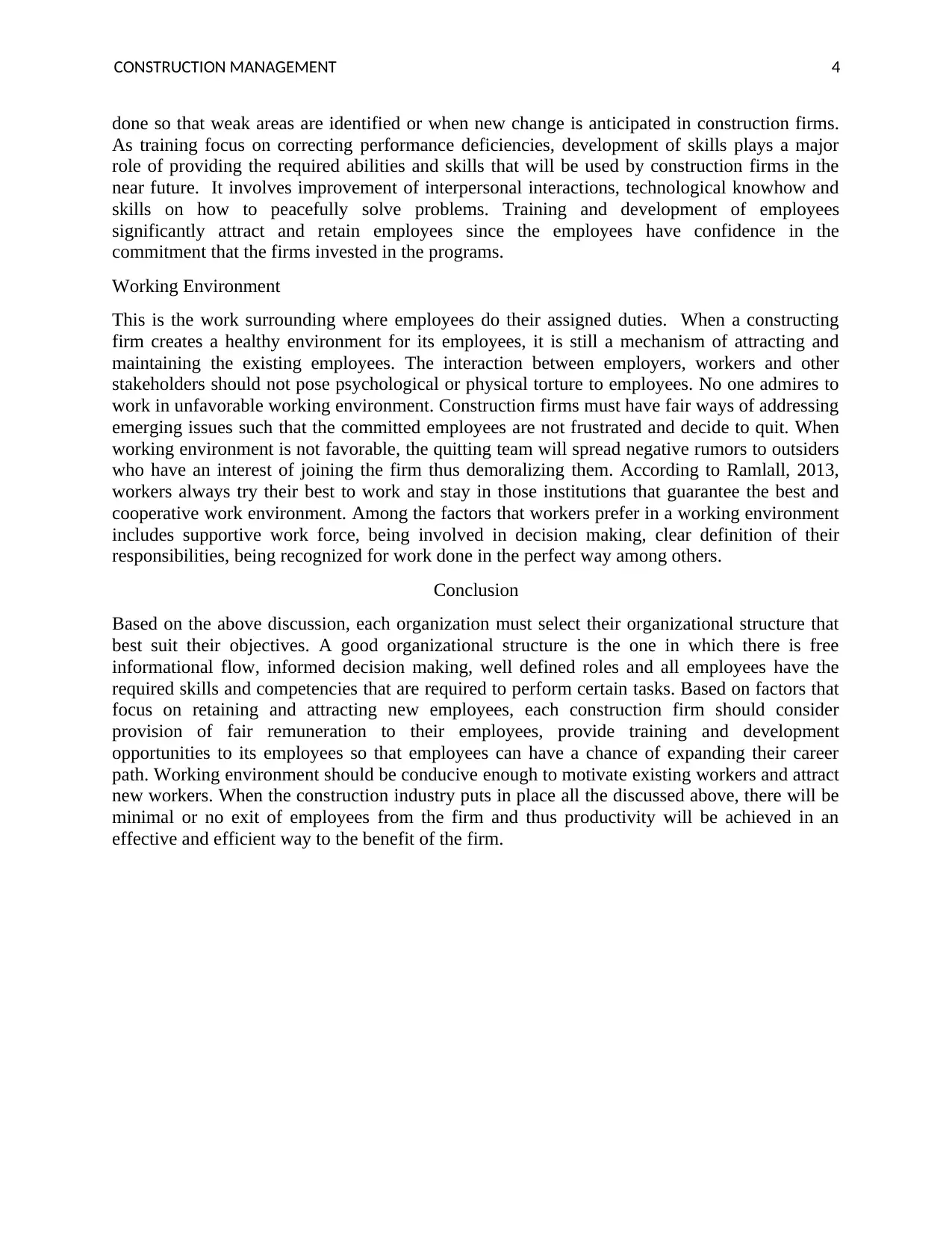
CONSTRUCTION MANAGEMENT 4
done so that weak areas are identified or when new change is anticipated in construction firms.
As training focus on correcting performance deficiencies, development of skills plays a major
role of providing the required abilities and skills that will be used by construction firms in the
near future. It involves improvement of interpersonal interactions, technological knowhow and
skills on how to peacefully solve problems. Training and development of employees
significantly attract and retain employees since the employees have confidence in the
commitment that the firms invested in the programs.
Working Environment
This is the work surrounding where employees do their assigned duties. When a constructing
firm creates a healthy environment for its employees, it is still a mechanism of attracting and
maintaining the existing employees. The interaction between employers, workers and other
stakeholders should not pose psychological or physical torture to employees. No one admires to
work in unfavorable working environment. Construction firms must have fair ways of addressing
emerging issues such that the committed employees are not frustrated and decide to quit. When
working environment is not favorable, the quitting team will spread negative rumors to outsiders
who have an interest of joining the firm thus demoralizing them. According to Ramlall, 2013,
workers always try their best to work and stay in those institutions that guarantee the best and
cooperative work environment. Among the factors that workers prefer in a working environment
includes supportive work force, being involved in decision making, clear definition of their
responsibilities, being recognized for work done in the perfect way among others.
Conclusion
Based on the above discussion, each organization must select their organizational structure that
best suit their objectives. A good organizational structure is the one in which there is free
informational flow, informed decision making, well defined roles and all employees have the
required skills and competencies that are required to perform certain tasks. Based on factors that
focus on retaining and attracting new employees, each construction firm should consider
provision of fair remuneration to their employees, provide training and development
opportunities to its employees so that employees can have a chance of expanding their career
path. Working environment should be conducive enough to motivate existing workers and attract
new workers. When the construction industry puts in place all the discussed above, there will be
minimal or no exit of employees from the firm and thus productivity will be achieved in an
effective and efficient way to the benefit of the firm.
done so that weak areas are identified or when new change is anticipated in construction firms.
As training focus on correcting performance deficiencies, development of skills plays a major
role of providing the required abilities and skills that will be used by construction firms in the
near future. It involves improvement of interpersonal interactions, technological knowhow and
skills on how to peacefully solve problems. Training and development of employees
significantly attract and retain employees since the employees have confidence in the
commitment that the firms invested in the programs.
Working Environment
This is the work surrounding where employees do their assigned duties. When a constructing
firm creates a healthy environment for its employees, it is still a mechanism of attracting and
maintaining the existing employees. The interaction between employers, workers and other
stakeholders should not pose psychological or physical torture to employees. No one admires to
work in unfavorable working environment. Construction firms must have fair ways of addressing
emerging issues such that the committed employees are not frustrated and decide to quit. When
working environment is not favorable, the quitting team will spread negative rumors to outsiders
who have an interest of joining the firm thus demoralizing them. According to Ramlall, 2013,
workers always try their best to work and stay in those institutions that guarantee the best and
cooperative work environment. Among the factors that workers prefer in a working environment
includes supportive work force, being involved in decision making, clear definition of their
responsibilities, being recognized for work done in the perfect way among others.
Conclusion
Based on the above discussion, each organization must select their organizational structure that
best suit their objectives. A good organizational structure is the one in which there is free
informational flow, informed decision making, well defined roles and all employees have the
required skills and competencies that are required to perform certain tasks. Based on factors that
focus on retaining and attracting new employees, each construction firm should consider
provision of fair remuneration to their employees, provide training and development
opportunities to its employees so that employees can have a chance of expanding their career
path. Working environment should be conducive enough to motivate existing workers and attract
new workers. When the construction industry puts in place all the discussed above, there will be
minimal or no exit of employees from the firm and thus productivity will be achieved in an
effective and efficient way to the benefit of the firm.
Paraphrase This Document
Need a fresh take? Get an instant paraphrase of this document with our AI Paraphraser
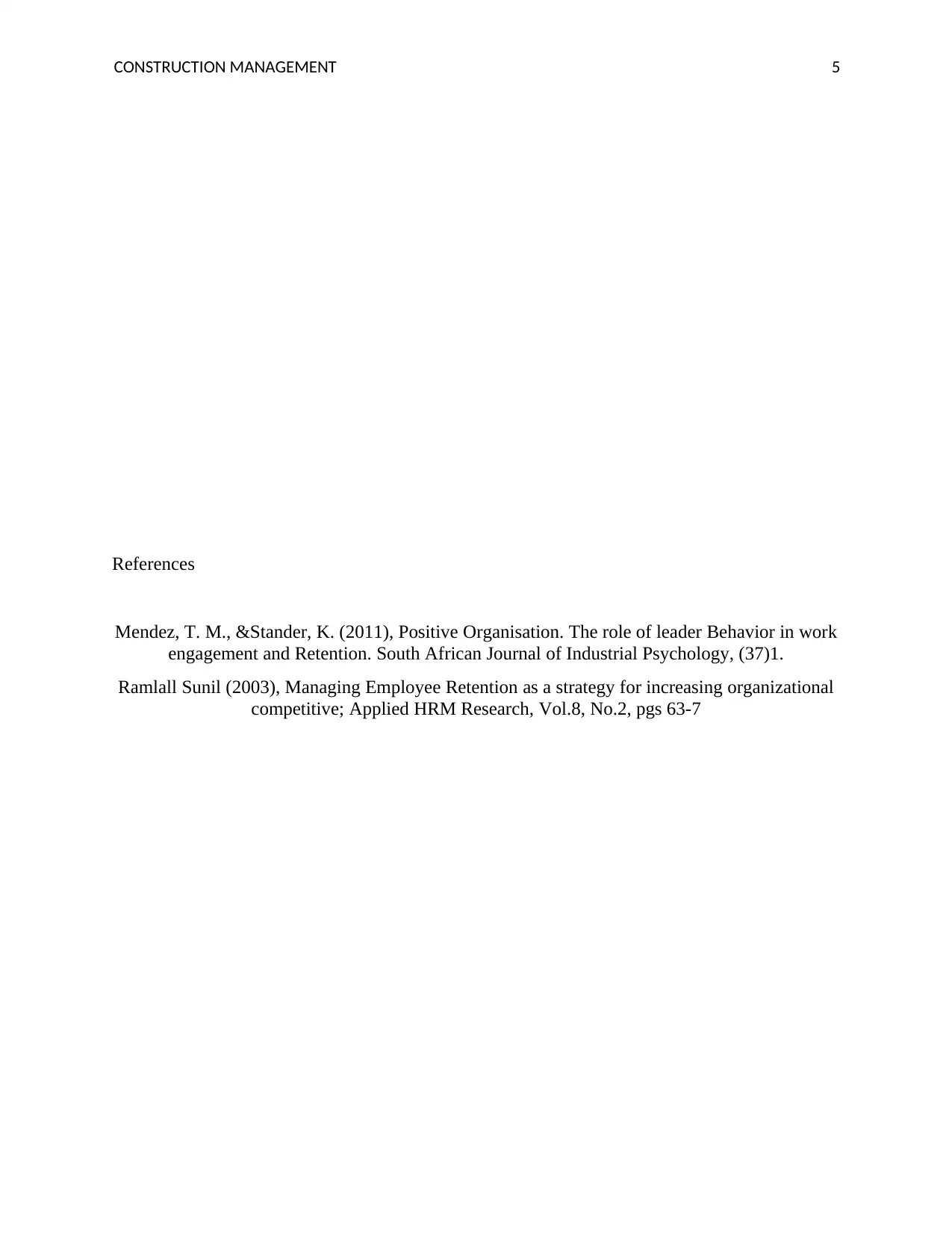
CONSTRUCTION MANAGEMENT 5
References
Mendez, T. M., &Stander, K. (2011), Positive Organisation. The role of leader Behavior in work
engagement and Retention. South African Journal of Industrial Psychology, (37)1.
Ramlall Sunil (2003), Managing Employee Retention as a strategy for increasing organizational
competitive; Applied HRM Research, Vol.8, No.2, pgs 63-7
References
Mendez, T. M., &Stander, K. (2011), Positive Organisation. The role of leader Behavior in work
engagement and Retention. South African Journal of Industrial Psychology, (37)1.
Ramlall Sunil (2003), Managing Employee Retention as a strategy for increasing organizational
competitive; Applied HRM Research, Vol.8, No.2, pgs 63-7
1 out of 5
Related Documents
Your All-in-One AI-Powered Toolkit for Academic Success.
+13062052269
info@desklib.com
Available 24*7 on WhatsApp / Email
![[object Object]](/_next/static/media/star-bottom.7253800d.svg)
Unlock your academic potential
Copyright © 2020–2025 A2Z Services. All Rights Reserved. Developed and managed by ZUCOL.





